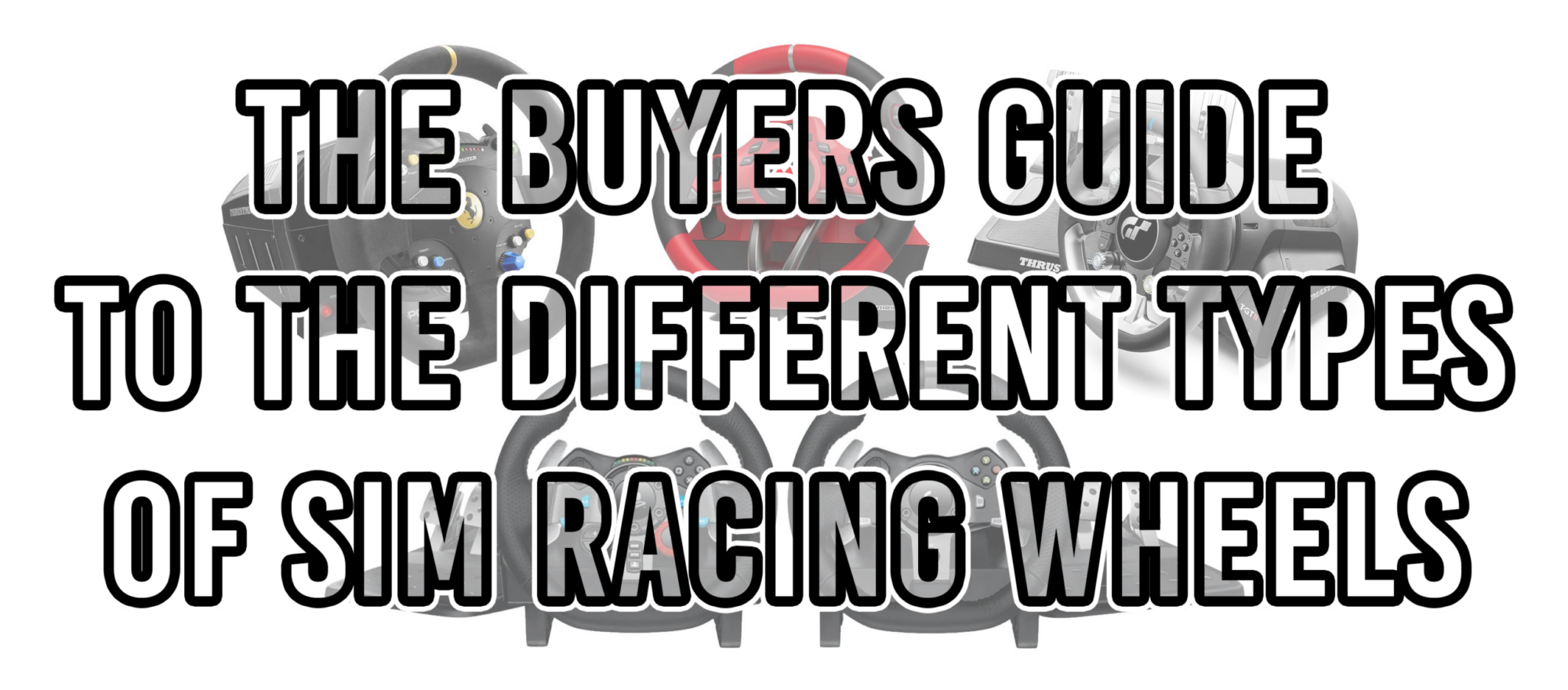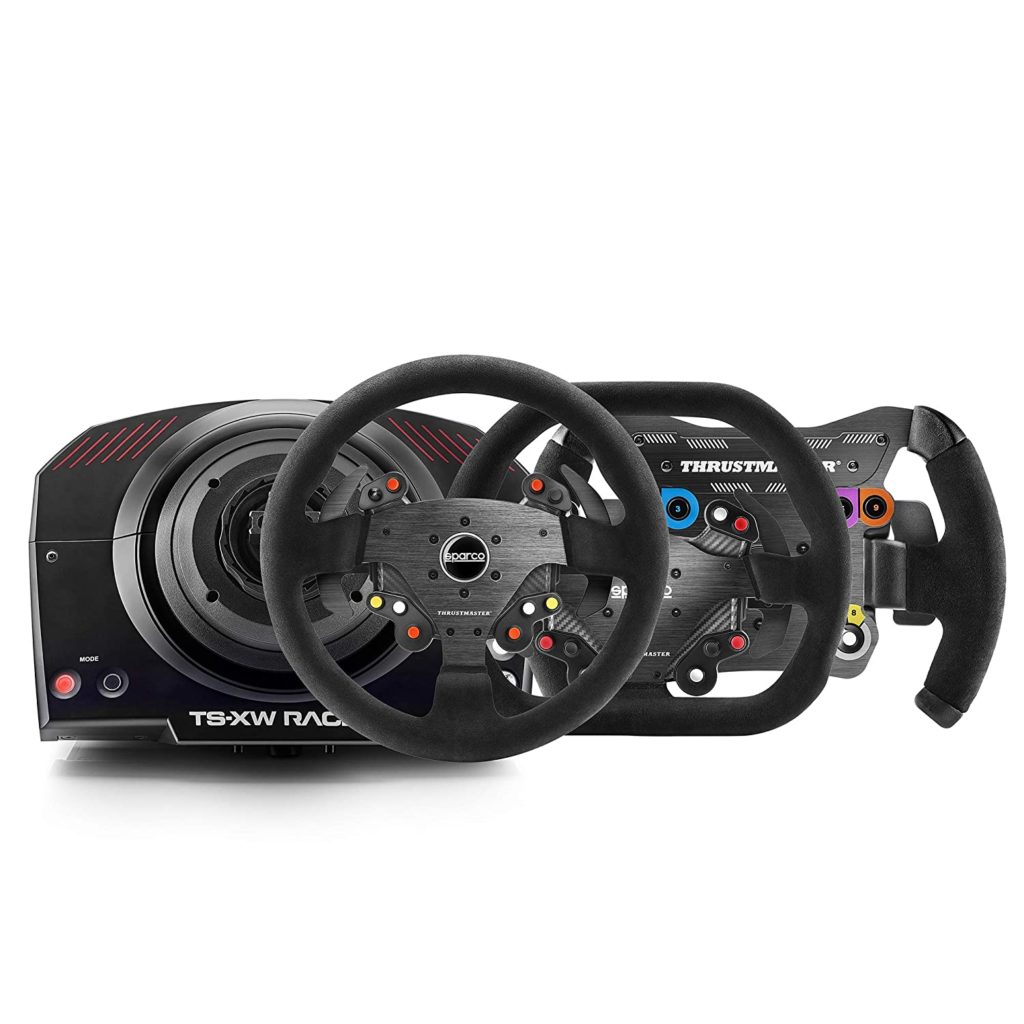If you’re anything like me, you dove headfirst into Sim Racing after purchasing the first wheel recommended to you by another driver and that was somewhat affordable. When I first started, I had no idea that there were different types of sim racing wheels. I was genuinely unaware that there were people using wheel bases with different rims based on the style of racing they were participating in. I didn’t know that you could pair your wheel with pedals from a totally different company and make your racing experience more realistic. But the more I fell in love with sim racing and began to take it seriously, the more I longed to upgrade my entry level setup for something sophisticated. When I started shopping for sim racing equipment, I was completely overwhelmed by the abundant wheel options, the lack of information and explanation regarding their abilities, and the reasons why their pricing could fluctuate so dramatically. That’s why I decided to create this buyers’ guide to help online racers find the sim racing wheel that is perfect for you and your budget.
There are three main types of sim racing wheels: Gear-Drive, Belt-Drive, and Direct-Drive, listed in order of lowest-to-highest average expense. I recommend starting from the beginning and upgrading your setup as your progress in your sim racing journey from rookie, to veteran, to expert.
For The Sim Racing Rookie: Gear-Drive, The Most Affordable Sim Racing Wheels
The most affordable sim racing wheels are gear-driven, with a lightweight and fairly portable electric motor that acts on a set of variables to simulate steerage effort. The best gear-driven wheels offer at least 900 degrees of turn, with plenty of easily accessible switches to make changes to the car setup while on-the-move, or to navigate your racing platform’s options menu that is found on the face of the wheel. While gear-driven wheels aren’t as quick to react or as accurate in their feel as some of the more expensive belt or direct-drive options, these wheels do come at a price point that most everyone can afford. Their convenience is unmatched, as they are typically bundled with paddle shifters and pedals to get you on track swiftly and without having to piece together each item of equipment. Additionally, they come with built-in clamps, providing a simple, sturdy way to mount your set-up to a desk or table, avoiding the need to invest in a cockpit quite yet.
I would personally recommend a gear-drive sim racing setup to anyone who is just getting started. However, when you’re shopping for a more affordable version of an item that is normally far more expensive, you need to be careful in your selection. After doing significant research, I believe the highest quality product in this category is the Logitech G920 Sim Racing Wheel & Pedals. There are two versions available for this wheel and pedal sim racing setup: Xbox or Playstation (Logitech G29), and both versions also work for PC. The Logitech G920 costs around $300, and is undoubtedly the best sim racing steering wheel and pedals in that price range because of its high quality materials, abundance of accessories, and overall bang for your buck. The dual-motor force feedback system on this sim racing wheel is realistic, strong, and does an impressive job of helping you physically feel and react to changes in the racing surface and obstacles in your path. This is the wheel I used when I first started sim racing, and I was incredibly impressed by the high quality of the wheel for its very fair price. The wheel is wrapped in a soft leather that has just the right amount of grip and feels natural and comfortable in your hands, which is a must-have for longer races. The wheel performs 900 degree turns, which is the same as a real race car and is the standard for sim racing.
The stainless steel pedals feel sturdy, strong, and provide ample brake pressure, another important element in sim racing. For shifting, there are paddle shifters on the wheel and a clutch pedal at your feet. The paddles click whenever an up or down shift is performed, which provide a satisfying and responsive manual transmission experience. The Logitech G920 also comes with an excellent mounting system that easily allows tight mounting to a desk or table.
The ample accessories available for this wheel and pedal setup also give you the ability to upgrade your equipment as you progress in your sim racing journey, without having to spend a significant amount of money on a totally new setup. For example, you can switch to an H-Pattern six-speed with the Logitech G Driving Force Shifter, or achieve a more realistic feel and heavier pressure from your pedals with this Pedal Inverting Kit
For The Sim Racing Veteran: Belt-Drive, Sim Racing Wheels and Pedals With The Best Bang For Your Buck
Once you have some sim racing experience under your belt, stepping up to the next level brings you into the arena of the more advanced belt-drive sim racing rigs. This type of setup commonly uses larger, heavier-duty motors that drive a belt which actuates on the steering shaft. This is also where we enter the territory of setups where the motor (or belt-drive) and steering wheel (or rim) are two different pieces. Buying multiple steering wheels for your belt-drive is totally optional, as purchasing multiple rims can become pricey. However, if you can swing the price tag, it is a big advantage to have the option of using the specific wheel that best caters to each series you are racing in. Aside from the increased customization opportunities, additional benefits over gear-drive setups are the capability to handle more powerful and accurate force feedback with less noise and with smooth, swift action. While these types of wheels can also be mounted on a desk or table, they tread into a competitive enough arena that you should consider pairing them with a cockpit racing seat that has mounts for the wheel, pedals, and shifter. The OpenWheeler GEN3 Cockpit is a high quality, sturdy, and versatile cockpit that is priced extremely fair for what you get. This is what I use and I have nothing but praise for this cockpit. You also may start to find pedals with load-cells at this price point. Load-cells transmit braking pressure based on how hard the driver pushes on the pedal, which is more accurate in feeling the way an actual hydraulic braking system feels in a racecar. This means that you push harder to stop quicker, instead of pushing further.
A great example of a high quality and slightly more affordable sim racing belt-drive set-up would be the Thrustmaster TX Servo Base paired with one of their wide variety of wheel choices and their sturdy, incredibly high quality, and flat out gorgeous T-LCM Pedals. These Thrustmaster sim racing wheel and pedals are my personal favorite, and what I still use to this day. They are made of exceptional materials that create a particularly immersive and satisfying driving experience, while providing elite force feedback and braking pressure that allows you to truly understand and interact with your racecar.
For The Sim Racing Expert: Direct-Drive, The Most Expensive Sim Racing Wheels and Pedals
Now, you have reached the cream of the crop, as good as it gets: the direct-drive sim racing rig. Before we go any further, I feel a few disclaimers are in-order. First off, in terms of moolah, we’re talking 4 figures at this point. You simply are not going to find a brand new, modern direct-drive system from a reputable company for under one thousand dollars. If you do, run the other way; because you get what you pay for. Second, this setup is not physically safe for rookies. Yeah, seriously. If you watch an in-car video of a modern real-life Indy Car or NASCAR driver about to take a huge hit into the wall, you will almost always see them remove their hands from the steering wheel and hold them to their chest a few moments before and after impact. They do this because leaving your hands on the wheel leaves you very vulnerable to a broken wrist or bone in your hand when the wheel inevitably performs a violent snap when the car makes impact with the wall – just ask Jimmie Johnson about this when he went to Long Beach in Indy Car this year. This may seem like I’m going on a tangent here, but this is important because the more complex your sim racing equipment gets, the more realistic your racing experience feels. If you hit the wall, your direct-drive sim racing set-up has the motor power and ability to do the exact same thing as a real racecar. YEAH, SERIOUSLY. And finally, you really shouldn’t be exploring a sim racing rig like this unless you also already own all the other primary elements that comprise a sim racing rig. You should already have a quality cockpit to mount this to, as the 30-pound motor that direct-drive rigs possess requires a very sturdy cockpit to support their weight and strength. Visually, you should be playing on a widescreen gaming monitor, multi-monitor set-up, or VR at this point in order to complete your realistic racing experience.
I have one more disclaimer – this one might be a little more controversial, but I think it’s important. I believe you should have hundreds of hours of sim racing experience and a decent amount of success online on your racing platform (whether it be on iRacing, Corsetta, or something else) before you consider upgrading to a sim racing setup of this caliber and expense. I say this because I have seen literally hundreds of “for sale” listings online from people who have never sim raced before, put in under 10 hours on a rig they purchased for more than 10 thousand dollars, and then decide that sim racing is “not for them.” Buying an expensive sim racing rig does not make racing easier, it makes it more realistic, which means it would actually make it more difficult for someone who is new to it. If you start with a gear-drive wheel and work your way up to a direct-drive, not only will you appreciate the higher quality materials, powerful feedback motors, and superior driving experience to the previous tier, but you will also know exactly how to apply these features and translate them into success on the track due to everything you’ve learned from your hours of experience.
Once you’re ready, a direct-drive sim racing rig will provide you with the most realistic, immersive, and versatile set-up you will ever find outside of a real racecar. Like I stated earlier, these rigs can be heavy, and need to be mounted to a cockpit that can handle the powerful force feedback that these wheels possess. The direct-drive system that we recommend is the Fanatec DD2 Wheel Base which pairs with several incredibly high quality and capable wheel rims. I personally view Fanatec as the Rolls Royce or Rolex of sim racing (which is also why I recommended their belt-drive rig) due to their exceptional materials, reliability, diverse wheel set-ups, and the best force feedback in the game. There is a reason why the vast majority of sim racing pros use Fanatec – it’s simply the best out there. If you’re already willing to spend your money at this price point, you shouldn’t be cutting corners anywhere.
After reading this buyers’ guide, I hope you have an easier time navigating the different types of sim racing wheels, and finding the ideal setup that fits within your budget and compliments your driving style. Ultimately, all three categories of sim racing wheels provide the features to ensure that you have a fun and realistic experience that can make you competitive in any level of online sim racing. Take the plunge and choose one, and I’ll see you on the track!



